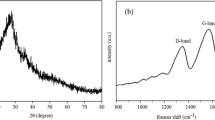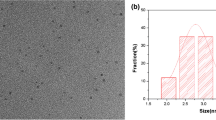Abstract
High-fluorescence Cu/N-codoped carbon quantum dots (Cu/NCQDs) were prepared by a one-step hydrothermal method using frangipani and copper acetate hydrate. The prepared Cu/NCQDs exhibited a nearly spherical morphology, and the average particle size was 2.58 nm. The surface of the Cu/NCQDs contains abundant hydrophilic groups –OH, –NH2 and –COOH, which explains their high water solubility. The Cu/NCQDs exhibited high-intensity, stable blue fluorescence that is independent of the excitation wavelength. As metronidazole can effectively quench the fluorescence intensity of Cu/NCQDs, a metronidazole fluorescence-detection method using Cu/NCQDs as the fluorescence probe was developed, and the quenching mechanism was studied. The method has the advantages of simplicity, speed, and low cost. Besides, the linear equation was F = − 3.235 + 9.064 C(MNZ)(μmol/L), the correlation coefficient (R2) was 0.996, and the detection limit was 0.28 μmol/L. Further, the metronidazole content in actual samples was determined using this method; the recovery rates of the metronidazole tablets and honey samples were 96.8–103.7%, and relative standard deviation was lower than 6%.









Similar content being viewed by others
References
Asma N et al (2022) New HPLC-UV analytical method for quantification of metronidazole: application to ex vivo ocular kinetic assessments following the administration of thermosensitive ocular in situ gel. Microchem J 172:106929
Bao WJ (2020) Preparation of doped carbon quantum dots by electrochemical method and application of metal ion detection. China University of Petroleum, Beijing
Bilici M, Zengin A, Ekmen E et al (2018) Efficient and selective separation of metronidazole from human serum by using molecularly imprinted magnetic nanoparticles. J Sep Sci 41:2952–2960
Chu X (2021) Preparation and multi-field application of functionalized carbon quantum dots doped with metal and non-metal. Nanning Normal University, Nanning
Chunmei Y (2019) Simultaneous determination of metronidazole and tetracaine hydrochloride in metronidazole coating by HPLC. Clin Ration Drug Use 12(2):118–119
Dan L (2019) Clinical effect of metronidazole combined with clindamycin in the treatment of bacterial vaginitis. Chin J Mod Drug Appl 15(18):134–136
Fan PF (2021) Synthesis of novel doped carbon quantum dots and their application in vitamin detection. Univ South China. https://doi.org/10.27234/,dcnki.Gnhuu.2021.000807
Fan D, Liu X, Shao X, Zhang Y, Zhang N, Wang X, Wei Q, Ju H (2021) A cardiac troponin I photoelectrochemical immunosensor: nitrogen-doped carbon quantum dots–bismuth oxyiodide–flower-like SnO2. Microchimica Acta Anal Sci Based Micro Nanomater 187(6):1–10
Fang L, Zheng J (2021) Carbon quantum dots: synthesis and correlation of luminescence behavior with microstructure. New Carbon Mater 36(3):625–631
Gao Hegang Du, Sai WR et al (2017) Determination of chloramphenicol and metronidazole residues in honey by ULTRA performance liquid chromatography-tandem mass spectrometry. J Prev Med 29(9):969–972
Haddao KM (2018) Investigation of metronidazole induced liver injury during early pregnancy in rats: a histological and histopathological studies. Indian J Public Health Res Dev 9(10):973
Han C et al (2021) Duplex metal co-doped carbon quantum dots-based drug delivery system with intelligent adjustable size as adjuvant for synergistic cancer therapy. Carbon 183:789–808
Hatamie A, Marahel F, Sharifat A (2018) Green synthesis of graphitic carbon nitride nanosheet (g-C3N4) and using it as a label-free fluorosensor for detection of metronidazole via quenching of the fluorescence. Talanta 176:518–525
Hu JK, Ligtenberg KG, Leventhal J, Bunick CG (2020) Successful management of malodor from fungating tumors using crushed metronidazole tablets. JAAD Case Rep 6(1):26–29
Hu X, Zhang H, Liu M (2021) A cucurbit[7]uril-based supramolecular fluorescent probe for the detection of metronidazole with high sensitivity and strong anti-interference capacity. J Chem Res 45(11–12):1068–1075
Kou X et al (2019) A review: recent advances in preparations and applications of heteroatom-doped carbon quantum dots. Dalton Trans an Int J Inorganic Chem 49(21):6915–6938
Lei Q (2021) Preparation of doped carbon point and its application in metal ion and drug detection. Shanxi University China, Shanxi. https://doi.org/10.27284/dcnki.Gsxiu.2021.000146
Lei HY, Guo JB, Lv Z et al (2018) Simultaneous determination of nitroimidazoles and quinolones in honey by modified QuEChERS and LC-MS/MS Analysis. Int J Anal Chem 2018:1–12
Lei H (2018) Residual Monitoring and Removal of Metronidazole and ofloxacin from honey. Northwest University, Washington
Li CJ, Wang YQ, Zhang XJ et al (2018) Red fluorescent carbon dots with phenylboronic acid tags for quick detection of Fe(III) in PC12 cells. J Colloid Interface Sci 526:487–496
Li Y, Hantao G, Meihua X, Shikong L, Bixia Y, Wen W (2020) Synthesis of iron doped carbon quantum dots by hydrothermal method and its application in H2O2 and dopamine detection. Chem Reagents. https://doi.org/10.13822/j.carolcarrollnkiHXSJ.2020007470
Li Meina LIANG, Wenhui ZQ (2019) Determination of metronidazole in toner by carbon paste electrode modified with multi-wall carbon nanotubes. Chem Anal Metrology 28(2):54–60
Liang XM (2019) Based on the doped carbon point sensing platform building and applications. Shanxi Normal University, Shanxi
Lin LP, Luo YX, Tsai PY et al (2018) Metal ions doped carbon quantum dots: synthesis, physicochemical properties, and their applications. Trends Anal Chem 103:87–101
Liu YS, Wu P, Wu XY et al (2020) Nitrogen and copper(II) co-doped carbon dots for applications in ascorbic acid determination by non-oxidation reduction strategy and cellular imaging. Talanta 210:120649–120658
Li Q (2020) One-pot synthesis of 2,2’-dipicolylamine derived highly photoluminescent nitrogen-doped carbon quantum dots for Fe3+ detection and fingermark detection. Nanotechnology 31(33):335501
Ma YS, Cen Y, Sohail M et al (2020) A ratiometric fluorescence universal platform based on N, Cu co-doped carbon dots to detect metabolitesparticipating in H2O2-generation reactions. ACS Appl Mater Interfaces 9(38):33011–33019
Nadendla RR et al (2021) A novel synchronic estimation of metronidazole, ciprofloxacin and doxycycline by RP-HPLC in bulk and pharmaceutical formulation. J Pharm Res Int 354–362
Qing W et al (2020) Cu2+-doped carbon dots as fluorescence probe for specific recognition of Cr(VI) and its antimicrobial activity. Microchem J 152:104262
Su RG (2018) Preparation mechanism of metal doped carbon spot and application of heavy metal detection. China University of Petroleum, Beijing
Su RG (2018) Preparation, mechanism and application of metal doped carbon dots in detection of heavy metals. China University of Petroleum, Beijing
Tang JH, Zhang YH, Liu YH et al (2019) Carbon quantum dots as a fluorophore for “inner filter effect” detection of metronidazole in pharmaceutical preparations. RSC Adv 9(65):38174–38182
Wan YY, Wang M, Zhang KL et al (2019) Facile and green synthesis of fluorescent carbon dots from the flowers of ABELMOSCHUS manihot (Linn.) medicus for sensitive detection of 2,4,6-trinitrophenol and cellular imaging. Microchem J 148:385–396
Xia YM et al (2021) Facile synthesis of reduced graphene oxide-octahedral mn3o4 nanocomposites as a platform for the electrochemical determination of metronidazole and sulfamonomethoxine. Electroanalysis 33(6):1646–1656
Xiaojiao R (2021) Amoxicillin metronidazole and rabeprazole combined treatment of gastric ulcer with helicobacter pylori infection efficacy and adverse reactions observation. Chin Med Clin 21(14):2528–2529
Si XJ, Deng LC, Xu X, Li L, Gong X (2022) Vanillin copper doped carbon quantum dots of fluorescence detection. J Food Ind Sci Technol Lancet (7):280–285. https://doi.org/10.13386/j.issn1002-0306.2021060242
Yang SL, Wang L, Zuo L et al (2018a) Non-conjugated polymer carbon dots for fluorometric determination of metronidazole. Microchim Acta 186(9):652–661
Yang XP, Liu MX, Yin YR et al (2018b) Green, hydrothermal synthesis of fluorescent carbon nanodots from gardenia, enabling the detection of metronidazole in pharmaceuticals and rabbit plasma. Sensors 18(4):964–979
Zhang Y (2019) Preparation and application of metal/nonmetal doped carbon quantum dots. Hebei University of Science and Technology, Shijiazhuang
Zemanová N et al (2022) Rapid determination of metronidazole and 2-hydroxymetronidazole in murine blood plasma. J Chromatogr Sci 60(1):81–87
Zhang J (2019a) Determination of the content of metronidazole fenbufen capsules by HPLC. J Harbin Med Univ 32(4):758–763
Zhang Z et al (2021) Polydopamine molecularly imprinted polymer coated on a biomimetic iron-based metal–organic framework for highly selective fluorescence detection of metronidazole. Talanta 232:122411
Zhang Y (2019b) Metal/nonmetal doping carbon quantum dots preparation and its application. Hebei University of Science and Technology, Shijiazhuang
Zhao JR, Pan XH, Sun XB et al (2018) Detection of metronidazole in honey and metronidazole tablets using carbon dots-based sensor via the inner filter effect. Luminescence 33(4):704–712
Zhou Yibing Wu, Kun LL et al (2017) Determination of metronidazole in honey by ULTRA-performance liquid chromatography-tandem mass spectrometry. Chin J Phys Chem Detect 53(8):946–949
Acknowledgments
This research was supported by Opening project of Guangxi Key Laboratory of Calcium Carbonate Resources Comprehensive Utilization No. HZXYKFKT201907.
Author information
Authors and Affiliations
Corresponding author
Ethics declarations
Conflict of interest
The authors declare no conflicts of interest.
Additional information
Publisher's Note
Springer Nature remains neutral with regard to jurisdictional claims in published maps and institutional affiliations.
Rights and permissions
Springer Nature or its licensor holds exclusive rights to this article under a publishing agreement with the author(s) or other rightsholder(s); author self-archiving of the accepted manuscript version of this article is solely governed by the terms of such publishing agreement and applicable law.
About this article
Cite this article
Lan, Y., Bao, W., Liang, C. et al. Synthesis of copper–nitrogen codoped carbon quantum dots using frangipani as a carbon source and application of metronidazole determination. Chem. Pap. 77, 1005–1015 (2023). https://doi.org/10.1007/s11696-022-02487-4
Received:
Accepted:
Published:
Issue Date:
DOI: https://doi.org/10.1007/s11696-022-02487-4




